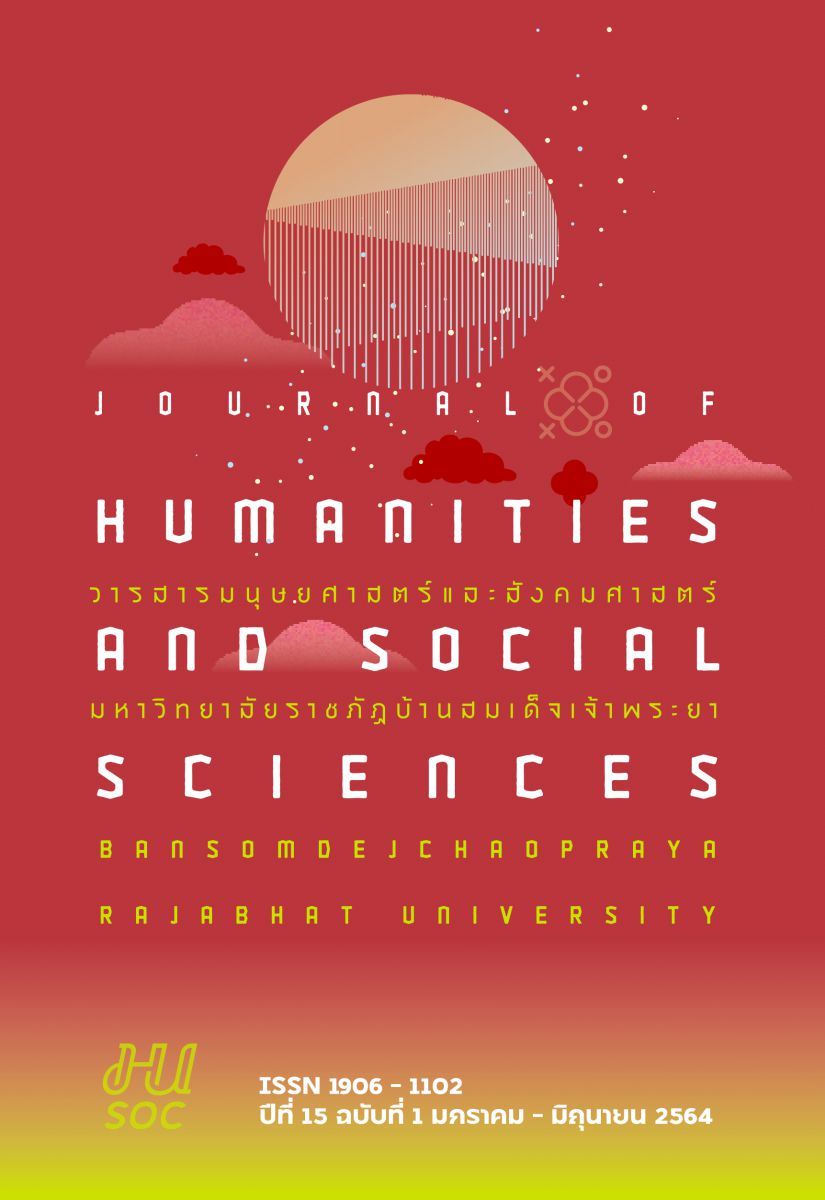The Use of Songs to Promote the Participation in Environmental Conservation of Chiangmai People
Keywords:
Music, Songs, Environmental Conservation, Small Dust Problems, Smog ProblemsAbstract
Dust and smog pollution, especially the particulate matter 2.5 (PM 2.5) and the particulate matter 10 (PM 10) have been the problems that Chiang Mai people have encountered for about 14 years. Particularly, in the year 2019, the number of small particles measured by the air quality indicator “US AQI” had reached the level of 246, the highest world ranking. This revealed that the government’s effort in undertaking environmental problems was unsuccessful. Therefore, people’s participation is imperative. Music has been composed in the form of songs and used to create inspiration toward environmental conservation for many decades. This article aims to demonstrate the relationship between music and nature, the evolution of songs in inspiring environmental conservation, and the components of music that were used to create inspiration for environmental conservation, and to suggest the elements of the songs that will help promote the participation in environmental conservation of Chiang Mai people. To compose those songs, it is important to consider the target audience’s preferences toward music and create the elements of the music, such as, content, melody, rhythm, and harmony that can meet their music tastes. The songs should contend the essences concerning the appreciation of the local environment, the awareness of environmental issues, and the call for the people’s participation in the environmental conservation in Chiang Mai.
References
คฑาวุธ ทองไทย. (2562, พฤษภาคม-สิงหาคม). การศึกษาเพลงเพื่อชีวิตของไทย: จากแนวพัฒนาการสู่การวิเคราะห์การประกอบสร้างวาทกรรมทางสังคม. วารสารรูสมิแล, 40(2), 15-26.
คมชัดลึก. (2563). บ่าววี ชวนคนรักธรรมชาติ ดูคอนเสิร์ตดนตรีเพื่อธรรมชาติและชีวิต. สืบค้น 22 ธันวาคม 2563, จาก https://www.komchadluek.net/news/ent/88927
คอร์ดอีซี่. (2559). คอร์ดเพลงดอกไม้ Salina & Sarinya. สืบค้น 23 พฤศจิกายน 2563, https://www.chordeasy.net/2016/09/selina-sirinya-flower.html
ตติยา สายบัวพัตร. (2555, มกราคม-มิถุนายน). เพลงโฟล์คซองคําเมืองของสุนทรี เวชานนท์. พิฆเนศวร์สาร, 8(1), 17-24.
เชียงใหม่นิวส์. (2563). My Hometown by RJ เพื่อเมืองเชียงใหม่อันเป็นที่รัก. สืบค้น 8 มกราคม 2564. https://www.chiangmainews.co.th/page/archives/1340705/
ไทยนิวส์รายวัน. (2557). คนเชียงใหม่ชี้สภาพแวดล้อมเริ่มเสื่อมโทรม. สืบค้น 15 มิถุนายน 2563, จาก http://www.thainews70.com/ข่าวเกษตรกรรม/คนเชียงใหม่ชี้สภาพแวดล/
ผู้จัดการออนไลน์. (2561). 10 บทเพลงอนุรักษ์ธรรมชาติ แด่ป่า-แด่สัตว์ที่ไปไม่ถึงต่อมสำนึกของนักล่าสัตว์ใจทราม/บอนบอระเพ็ด. สืบค้น 1 กรกฎาคม 2563, จาก https://mgronline.com/entertainment/detail/9610000012530
ผู้จัดการออนไลน์. (2563). มาดามแป้งเปิดใจ “ในวันที่โลกเปลี่ยนไป”. สืบค้น 1 กรกฎาคม 2563. https://mgronline.com/mutualfund/detail/9630000028709
สำนักงานจังหวัดเชียงใหม่. (2560). ข้อมูลทั่วไปของจังหวัดเชียงใหม่. สืบค้น 15 มิถุนายน 2563, จาก https://www.chiangmai.go.th/managing/public/D8/8D01Feb2017150134.pdf.
หนังสือพิมพ์ไทยโพสต์. (2563). ถอดบทเรียน 14 ปี แก้หมอกควันภาคเหนือ “ล้มเหลว - ซ้ำรอยเดิม” สืบค้น 25 ธันวาคม 2563, จาก https://www.thaipost.net/main/detail/66641
อัจฉรีย์ ทิพธนธรณินทร. (2558, กรกฎาคม - ธันวาคม). แนวทางการแก้ปัญหาหมอกควันสำหรับจังหวัดเชียงใหม่. วารสารด้านการบริหารรัฐกิจและการเมือง. 4(1), 72-105.
โอเคเนชั่น. (2553). จอห์น เดนเวอร์ ยังไม่ตาย. สืบค้น 20 ธันวาคม 2563, จาก http://oknation.nationtv.tv/blog/print.php?id=649176
Abrahams, F. (2015, September). Another perspective: teaching music to millennial students. Music Educators Journal, 102(1), 97-100.
Allen, A. (2012, June). Ecomusicology: music, culture, nature and change in environmental studies? Journal of Environmental Studies and Sciences, 2(2), 192–201.
Arons, W. & May, T.J. (2012). Readings in performance and ecology. New York: Palgrave Macmillan.
Benward, B., & Saker,M. (2014). Music in theory and practice. (9th ed.). New York: McGraw-Hill.
Casas-Mas, A., Pozo, J., & Montero, I. (2014, November). The influence of music learning cultures on the construction of teaching learning conceptions. British Journal of Music Education, 31(3), 319-342.
Collins, J. (2011). Good to great: why some companies make the leap ... and others don’t. New York: Harper Business.
Encyclopedia of Biography. (2020). John Denver biography. Retrieved 1 April 2020, from https://www.notablebiographies.com/supp/Supplement-Ca-Fi/Denver-John.html
Folkestad, G. (2006, June). Formal and informal learning situations or practices vs formal and informal ways of learning. British Journal of Music Education, 23(2), 135-145.
Garett, G. H. (2013). The grove dictionary of American music. (2nd Ed). Oxford: Oxford University Press.
Georgii-Hemming, E. & Westvall, M. (2010, March). Music education—a personal matter? examining the current discourse of music education in Sweden. British Journal of Music Education, 27(1), 21-33.
Hallam, S. (2012). “Commentary: instrumental music.” in The Oxford Handbook of Music Education, I, ed.Gary Macpherson & G. Welch, (pp. 651–57). Oxford: OxfordUniversity Press.
Hallam, S. (2015). The impact of actively making music on the Intellectual, social and personal development of children and young people: a research synthesis. London: IMerc.
Helmick,A. (2011). The greening of American music: environmentalism in song. (Doctoral dissertation), Munchen: Ludwig-Maximilians-Universitat Munchen.
Higgins, L. (2015). My voice is important too: non-formal music experiences and young people. In McPherson, G. (Ed.), The child as musician: a handbook of musical development.Oxford, UK: Oxford University Press.
Ingram, D. (2007, December 2006-March 2007). ‘Go to the forest and move’: American Rock Music as Electric Pastoral. 49th Parallel, 20, 1–16.
Juslin, N. P. & Timmers, R. (2010). Expression and communication of emotion in music performance. In: P. N. Juslin & J. A.Sloboda (Eds.). Music and emotion. Theory, research, applications (453-489). United Kingdom: Oxford University Press.
Manabe, N. (2015). The revolution will not be televised: protest music after Fukushima. NewYork: Oxford University Press.
McPhail, G. (2013, June). Developing student autonomy in the one-to-one music lesson. International Journal of Music Education, 31(2), 160–172.
Pedelty, M. (2012). Ecomusicology. Philadelphia, PA: Temple University Press.
Pedelty, M. (2016). A Song to save the Salish Sea: Musical Performance as Environmental Activism. Bloomington: Indiana University Press.
Rabinovitch, T-C., Cross, I., & Burnard, P. (2013, July). Long-term musical group interaction has a positive influence on empathy in children. Psychology of Music, 41(4), 484-498.
Rehding, A. (2011, May-August). Ecomusicology between Apocalypse and Nostalgia. Journal of the American Musicological Society. 64(2), 409–414.
Rosenthal, D.J. (2006, August). ‘Hoods and the woods: rap music as environmental literature. The Journal of Popular Culture, 39(4), 661–676.
Schafer, R.M. (1994). The soundscape: our sonic environment and the tuning of the world. Rochester, VT: Destiny Books.
Vesper, C., van der Wel, R., Knoblich, G., & Sebanz, N. (2011, June). Making oneself predictable: reduced temporal variability facilitates joint action coordination. Experimental Brain Research, 211(3), 517-530.
Downloads
Published
How to Cite
Issue
Section
License
Copyright (c) 2021 Faculty of Humanities and Social Sciences Bansomdejchaopraya Rajabhat University

This work is licensed under a Creative Commons Attribution-NonCommercial-NoDerivatives 4.0 International License.



